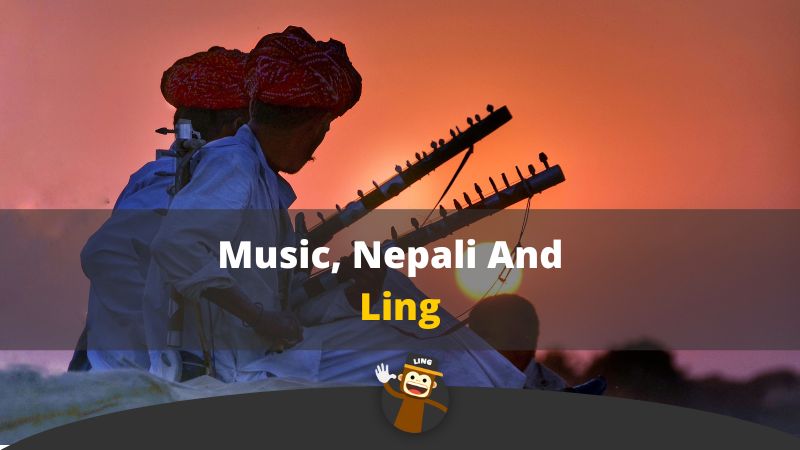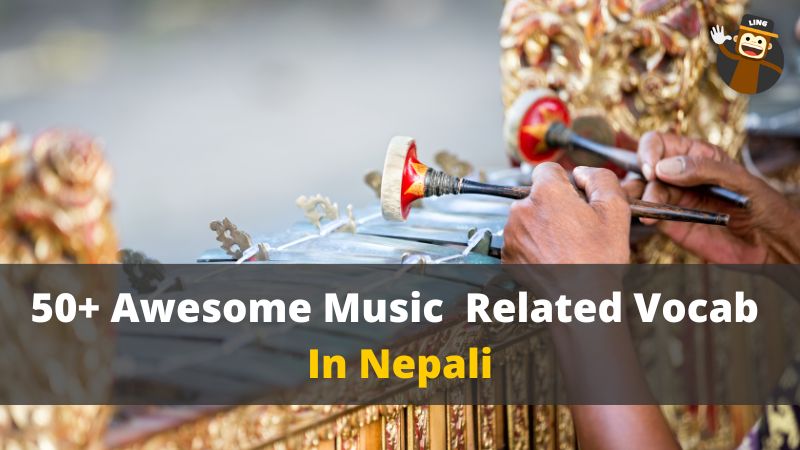The beauty of Nepal is breathtaking. It is the home of the Himalayas and holds the record of the World’s Highest Peak – Mt. Everest. Besides the background of snow-capped mountains, the culture is very diverse, and Nepal is filled with heritage sites.
Such beauty and culture are pretty inspiring. It is common for writers, artists, and adventurers to find zen energy while in Nepal. The same is true for most musicians. Here are 50 extraordinary music-related vocab in Nepali to share more about music.
Music In Nepal
Due to the diversity of the Nepali people, the music is also very diverse. There are different kinds of music genres related to the ethnic groups in Nepal. Some of these are Tamang Selo, Dohori, Adhunik Geet, Newa music, Tharu music, Gurung Music, Kirat Music, Bhajan, Ghazals, and many more.
Tamang music is a form of Nepali folk music. Hira Devi Waiba must be mentioned as she is the documented pioneer of Nepali folk songs. Tamang people use Dhampu and Tungna traditionally as instruments. Dhampu and Tungna are called the nail and flesh of a finger among the Tamang people. The instruments are often used during festivals and special occasions.
Adhunik Geet can be translated as modern songs, yet they are pretty old too! They began in the 1950s with a mixed influence of classical, folk, and western music. Bhajans are religious songs heard, often coming from homes or temples. They are from Hindu and Buddhist scriptures and are seen as a compulsory part of worship, and musical instruments are used too.
Ghazal is a very poetic musical genre written and influenced by love, life, and loss. They are primarily slow songs.
These genres mentioned are part of Nepali’s vocab related to music that many fans will come across.
Music Vocabulary

Musical Instruments in Nepali – Vocab in Nepali
The following is a list vocab in Nepali language that helps carry out a conversation regarding music and musical instruments.
- drum – Ḍrama – ड्रम
- guitar – Gitāra – गितार
- beat – Tala – ताल
- chord – Tara – तार
- classical – Śāstrīya – शास्त्रीय
- composition – Racanā – रचना
- dance – Nr̥tya – नृत्य
- drumbeat – Ḍramapiṭa – ड्रमपिट
- flute – Bām̐surī – बाँसुरी
- folk – Lōka – लोक
- genre – Vidhā – विधा
- harmony – Sadbhāva – सद्भाव
- harp – Vīṇā – वीणा
- interval – Antarāla – अन्तराल
- loud – Carkō – चर्को
- lyric – Gīta – गीत
- masterpiece – Utkr̥ṣṭa namunā – उत्कृष्ट नमुना
- medley – Mēḍalē – मेडले
- melody – Dhuna – धुन
- modern – Ādhunika – आधुनिक
- music – Saṅgīta – संगीत
- musical instruments – Sāṅgītika bājā – सांगीतिक बाजा
- note – Nōṭa – नोट
- opera – Ōpērā – ओपेरा
- orchestra – Ārkēsṭrā – आर्केस्ट्रा
- performance – Pradarśana – प्रदर्शन
- piano – Piyānō – पियानो
- play – bajā’u – बाजा बजाउ
- program – Kāryakrama – कार्यक्रम
- rhythm – Tāla – ताल
- romantic – Rōmānṭika – रोमान्टिक
- secular – Dharmanirapēkṣa – धर्मनिरपेक्ष
- sacred – Pavitra – पवित्र
- sing/singing – Gā’unuhōs – गाउनुहोस्
- sitar – Sitāra – सितार
- solo – Ēklō – एक्लो
- song – Gīta – गीत
- spiritual – Ādhyātmika – आध्यात्मिक
- tempo – Ṭēmpō – टेम्पो
- tone – Ṭōna – टोन
- tune – Dhuna – धुन
- vocal – Svara – स्वर
Here is also a brief description of Nepali musical instruments that are very famous throughout the nation.
- Panche Baja: These are five musical instruments played explicitly in wedding ceremonies. Damaha – a drum made of leather that tightly covers a copper bowl, Tyamko – a small drum, Dholaki – a drum made of timber, Sanai – a flute and Narshingha – a traditional trumpet.
- Madal and Dhimay: They are also percussion instruments. Madal is considered as an essential instrument for Nepali folk music. Dhimay is the drum of Newar people and is often used in performances.
- Bansuri: This is the famous flute widely recognized all over India.
- Sarangi and Tungna: They are string instruments. Sarangi resembles a violin, and Tungna is more like a guitar for the Himalayans.
- Khainjadi, Dhamphu, and Dhyangro: These are types of drums. Tamang community uses Dhamphu often for their music. Faith healers use Dhyangro and believe it to have healing properties along with their music. Khainjadi is a small percussion instrument that looks a lot like a tambourine. It is often used in Bhajans and spiritual songs.
- Pungi: This is a flute-like instrument often used by snake charmers.
- Ekatare and Urni: These are both string instruments. Ancient priests used Ekatare and Urni is like a violin with a bow. Dhimal communities use it.
- Masak: It is a very old bagpipe instrument that was said to be used in weddings.
- Sankha: It is a large shell that is blown like a horn during several Hindu ceremonies and also during a burial.
- Irlung Pipari: It is used by religious leaders to blow off evil spirits from over homes. It is a small flute and is made of a black antelope.
- Tabala: This is a drum set (two make a set) used for several types of music like classical, traditional, and folk music. It is another widely known instrument in India.
- Dafli: This originated from the Muslim community in India. It is used for Bhajans and Kirtans (religious music). It looks much like the modern-day tambourine.
Music, Nepali And Ling

Though several of the vocab in Nepali mentioned here can be found in the Nepali dictionary, it is not always easy to learn the words this way. The vocab in Nepali shares or has borrowed many words from the English language, some of which can be noted from the given list.
Yet, learning Nepali words requires practice, and definitions, synonyms, pronunciation, and examples are needed to understand them.
This is where the Ling App can help! Ling is a free language learning app that provides lessons where you can learn Nepali vocabulary, English words, voice recordings, and so much more! With Ling, language learning becomes fun and engaging.
If you want to start learning the Nepali language, there’s no better way than with Ling! Download it today from the Apple Store or Google Play.




















